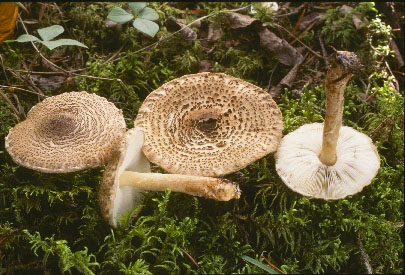Habitat/Adaptation/Nutrition
Lepiota josserandii are found single, scattered, or
in groups of cultivated ground. They are usually found under
bushes and trees fruiting in late summer and fall. In order to
spore they require an environmental cue. Stalk height, stalk
diameter and cap size are affected by temperature, humidity, and
fresh air. In North
America they are typically a northern California species, but
have recently been found in upper New York. It is also found in parts of India and is common in Europe
along with
Primula obconica.
Some fungi live on dead skin and hair on bodies. Lepiota
josserandii
like
Morchella esculentoides is immotile, multicellular,
heterotrophic, and has a unique way of eating. Many other
organisms like
Nycticebus
coucang ingest then digest, but fungi digest then ingest. They
have a vegetative growth form consisting of hyphae.
The hyphae stretch out at the tips and have branches called mycelium.
 Some
hyphae break through the chitin
walls of fungi and enzymes
then break down
molecules to absorb as nutrients. Fungi also use
the hyphae for
surface area
enhancement avoiding each other
staining DNA and RNA in the tips. Fungi are not dependent on
light, they can live in dark places and can grow in any
direction. The fungi body structure increases efficiency for
nutrient absorption and in fungi food is stored as glycogen.
Fungi may be Saprophytes- Use non-living organic material as
food. Parasites- Use organic material from living organisms,
harming them in some way. Fungi do not have a vascular system
like plants so their food and water transport is less efficient.
Most fungi in general gather their nutrients from dead organic material.
Some
hyphae break through the chitin
walls of fungi and enzymes
then break down
molecules to absorb as nutrients. Fungi also use
the hyphae for
surface area
enhancement avoiding each other
staining DNA and RNA in the tips. Fungi are not dependent on
light, they can live in dark places and can grow in any
direction. The fungi body structure increases efficiency for
nutrient absorption and in fungi food is stored as glycogen.
Fungi may be Saprophytes- Use non-living organic material as
food. Parasites- Use organic material from living organisms,
harming them in some way. Fungi do not have a vascular system
like plants so their food and water transport is less efficient.
Most fungi in general gather their nutrients from dead organic material.
Look below! These are hyphae cells and to the right is a microscopic view of a cell. Labeling 1.- hyphal wall, 2- septum, 3- mitochondrion, 4- vacuole, 5- ergosterol crystal, 6- ribosome, 7- nucleus, 8- endoplasmic reticulum, 9- lipid body, 10- plasma membrane, 11- the spitzenkorper (the tip of growth).
Fungi may be:
Decomposer fungi which breakdown and absorb nutrients from
nonliving organic material, such as fallen logs, animal corpses,
and the wastes of living organisms.
Parasitic fungi that absorb nutrients from the cells of living
hosts. Some are pathogenic, including species that affect human
lungs and other species that are responsible for about 80% of
plant disease.
Mutualistic fungi absorb nutrients from a host
organism, but they reciprocate with actions that benefit hosts.
As part of the basidiomycota, Lepiota josserandii is a
decomposer, but has an interesting way of
reproduction click the link to
find out!
Finding yourself lost? Try going back to the home
page to read again.
